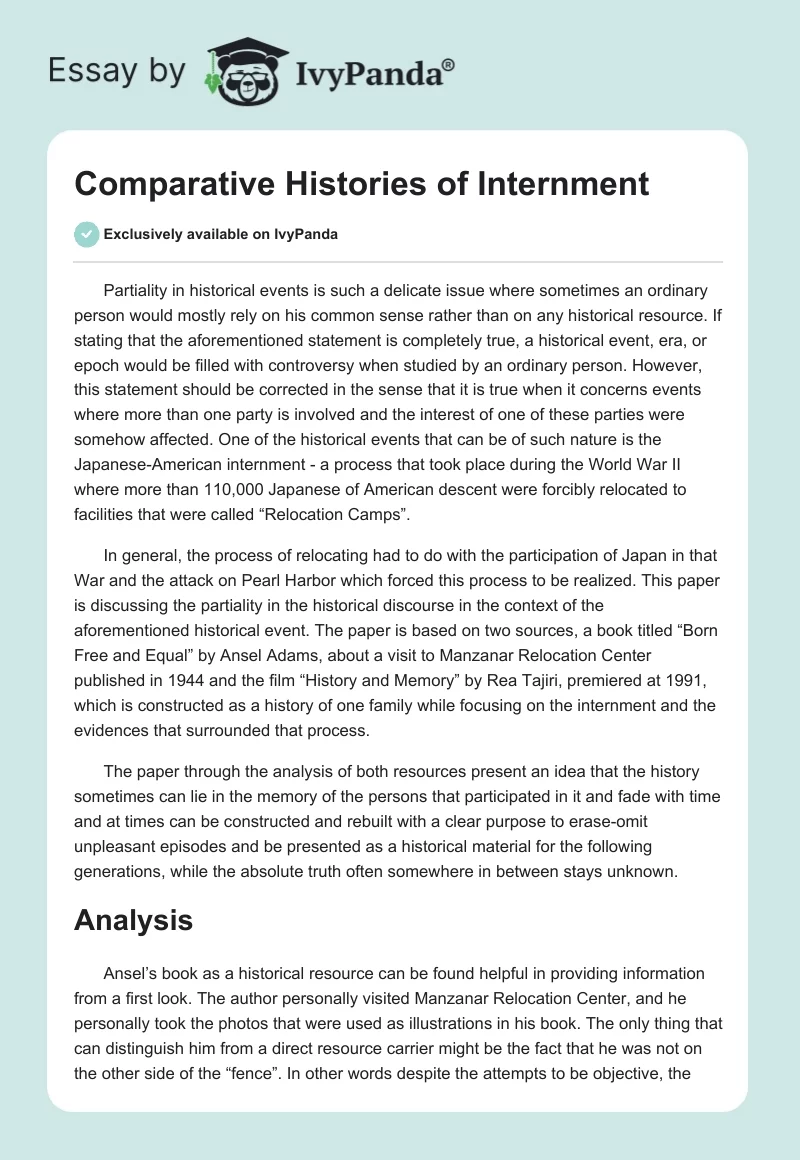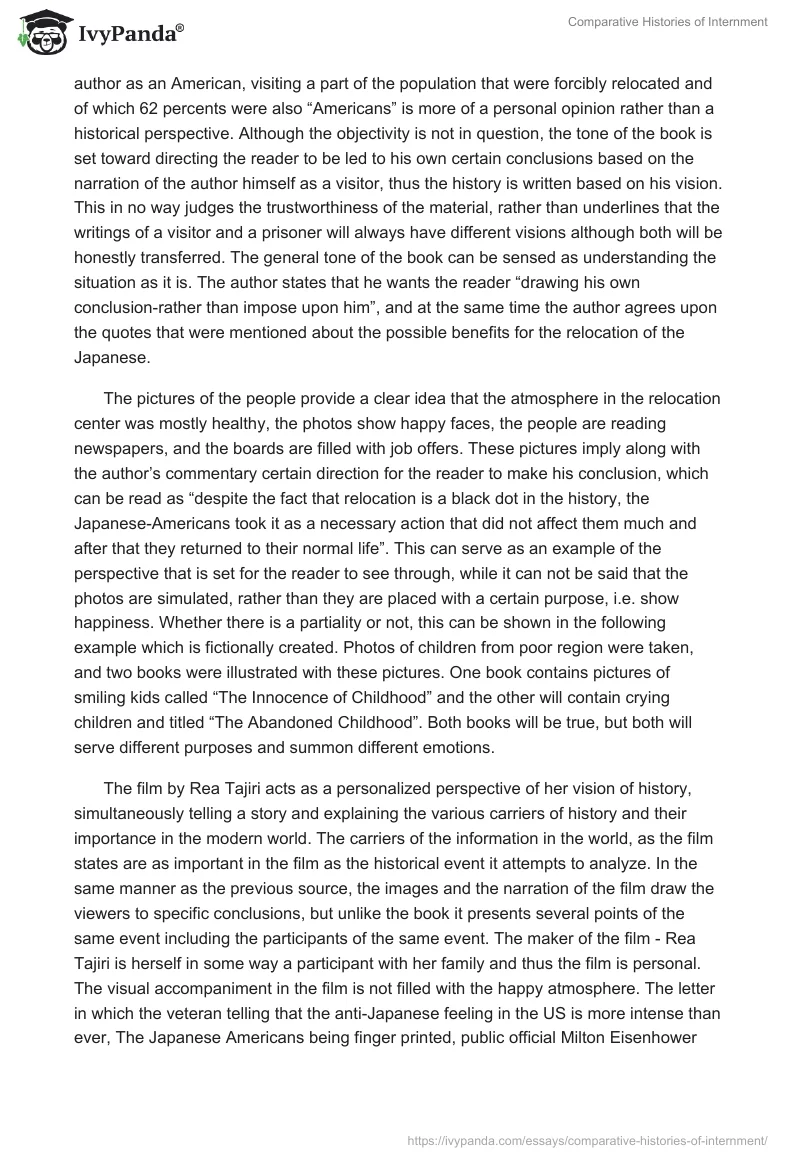Partiality in historical events is such a delicate issue where sometimes an ordinary person would mostly rely on his common sense rather than on any historical resource. If stating that the aforementioned statement is completely true, a historical event, era, or epoch would be filled with controversy when studied by an ordinary person. However, this statement should be corrected in the sense that it is true when it concerns events where more than one party is involved and the interest of one of these parties were somehow affected. One of the historical events that can be of such nature is the Japanese-American internment – a process that took place during the World War II where more than 110,000 Japanese of American descent were forcibly relocated to facilities that were called “Relocation Camps”.
In general, the process of relocating had to do with the participation of Japan in that War and the attack on Pearl Harbor which forced this process to be realized. This paper is discussing the partiality in the historical discourse in the context of the aforementioned historical event. The paper is based on two sources, a book titled “Born Free and Equal” by Ansel Adams, about a visit to Manzanar Relocation Center published in 1944 and the film “History and Memory” by Rea Tajiri, premiered at 1991, which is constructed as a history of one family while focusing on the internment and the evidences that surrounded that process.
The paper through the analysis of both resources present an idea that the history sometimes can lie in the memory of the persons that participated in it and fade with time and at times can be constructed and rebuilt with a clear purpose to erase-omit unpleasant episodes and be presented as a historical material for the following generations, while the absolute truth often somewhere in between stays unknown.
Analysis
Ansel’s book as a historical resource can be found helpful in providing information from a first look. The author personally visited Manzanar Relocation Center, and he personally took the photos that were used as illustrations in his book. The only thing that can distinguish him from a direct resource carrier might be the fact that he was not on the other side of the “fence”. In other words despite the attempts to be objective, the author as an American, visiting a part of the population that were forcibly relocated and of which 62 percents were also “Americans” is more of a personal opinion rather than a historical perspective. Although the objectivity is not in question, the tone of the book is set toward directing the reader to be led to his own certain conclusions based on the narration of the author himself as a visitor, thus the history is written based on his vision. This in no way judges the trustworthiness of the material, rather than underlines that the writings of a visitor and a prisoner will always have different visions although both will be honestly transferred. The general tone of the book can be sensed as understanding the situation as it is. The author states that he wants the reader “drawing his own conclusion-rather than impose upon him”, and at the same time the author agrees upon the quotes that were mentioned about the possible benefits for the relocation of the Japanese.
The pictures of the people provide a clear idea that the atmosphere in the relocation center was mostly healthy, the photos show happy faces, the people are reading newspapers, and the boards are filled with job offers. These pictures imply along with the author’s commentary certain direction for the reader to make his conclusion, which can be read as “despite the fact that relocation is a black dot in the history, the Japanese-Americans took it as a necessary action that did not affect them much and after that they returned to their normal life”. This can serve as an example of the perspective that is set for the reader to see through, while it can not be said that the photos are simulated, rather than they are placed with a certain purpose, i.e. show happiness. Whether there is a partiality or not, this can be shown in the following example which is fictionally created. Photos of children from poor region were taken, and two books were illustrated with these pictures. One book contains pictures of smiling kids called “The Innocence of Childhood” and the other will contain crying children and titled “The Abandoned Childhood”. Both books will be true, but both will serve different purposes and summon different emotions.
The film by Rea Tajiri acts as a personalized perspective of her vision of history, simultaneously telling a story and explaining the various carriers of history and their importance in the modern world. The carriers of the information in the world, as the film states are as important in the film as the historical event it attempts to analyze. In the same manner as the previous source, the images and the narration of the film draw the viewers to specific conclusions, but unlike the book it presents several points of the same event including the participants of the same event. The maker of the film – Rea Tajiri is herself in some way a participant with her family and thus the film is personal. The visual accompaniment in the film is not filled with the happy atmosphere. The letter in which the veteran telling that the anti-Japanese feeling in the US is more intense than ever, The Japanese Americans being finger printed, public official Milton Eisenhower explaining the logic of relocation, and the narration that the barracks were horse stable are images far from being representation of happiness.
Such images also can not be all true, not because they were fabricated, but because it is only a part of the whole image. A part that for a certain family that participated is true, but for the history only fragments that need other fragments to form the whole picture. The film is also significant in a way that it presents the concepts by which the history in many young minds are made and the importance of memories in forming the history, if not for the fact that they can be erased.
Conclusion
The two sources are perfect examples where the history of an event involving two parties is written by a representative of these parties. The comparison shows the differences between the separate visions on the same event. The book shows us that the history can not be written by a mere observance from one side no matter how objective the author wants to be, especially in years when human rights were dropped in favor of security. The film on the other hand shows that taking an event personally can be very honest but historically can not be neutral. Combining the two sources we come to the fact that the history is somewhere there in between.
In these days where the opinions can be manipulated by polls and surveys and where the absolute truth is something dependable on which side the person is standing, the only thing that remains to hold for is the history. In this paper it is shown that the history tends to be colored with different emotions which although honest gives the viewer or the reader different impression according to the presented “color”. It proves that the history would never be neutral because there will always be people for whom it will be personal.
Works Cited
Adams, Ansel, and Wynne Benti. Born free and equal. Bishop, CA: Spotted Dog Press, 2002. Web.
History and Memory: For Akiko and Takashige. Dir. Rea Tajiri. Washington State Arts Commission, 1992.


